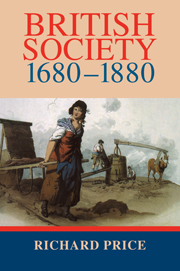Book contents
- Frontmatter
- Contents
- Preface
- Acknowledgments
- Introduction: beginnings, periods and problems
- 1 The economy of manufacture
- 2 A universal merchant to the world: the political economy of commerce and finance
- 3 The ambiguities of free trade
- 4 The reach of the state: taxation
- 5 The age of localism
- 6 The public, the private and the state: civil society 1680–1880
- 7 Exclusion and inclusion: the political consequences of 1688
- 8 Exclusion and inclusion: defending the politics of finality 1832–1885
- 9 The stabilities and instabilities of elite authority: social relations c.1688–c.1880
- Afterword
- Index
4 - The reach of the state: taxation
Published online by Cambridge University Press: 02 December 2009
- Frontmatter
- Contents
- Preface
- Acknowledgments
- Introduction: beginnings, periods and problems
- 1 The economy of manufacture
- 2 A universal merchant to the world: the political economy of commerce and finance
- 3 The ambiguities of free trade
- 4 The reach of the state: taxation
- 5 The age of localism
- 6 The public, the private and the state: civil society 1680–1880
- 7 Exclusion and inclusion: the political consequences of 1688
- 8 Exclusion and inclusion: defending the politics of finality 1832–1885
- 9 The stabilities and instabilities of elite authority: social relations c.1688–c.1880
- Afterword
- Index
Summary
Defining the Victorian state
In 1888, at the end of a series of lectures for the law tripos in the University of Cambridge, the constitutional historian, F. W. Maitland, remarked that modern statutes had vastly extended the powers of “councils and boards and officers, high and low, central and local.” England, he claimed, was fast becoming “a much governed nation.” This was a curious claim for Maitland to make. Maitland had just treated his students to several months of erudite consideration of the dense fabric of legal regulation that composed the English constitution. Yet this did not seem to count as “government,” even though Maitland was well aware that it was impossible to draw clear distinctions between, for example, constitutional law, administrative law, property law and even criminal law. By any account, Britain was a nation of laws that penetrated deep into the fabric of society, and from which it was impossible for even the lowliest to escape.
In proclaiming Britain to be a newly “much governed nation,” however, Maitland was reflecting a common conceit of his age. A. V. Dicey was to make the same point, in a different way, ten years later in a series of lectures at Harvard University. The main direction of modern legislation, Dicey argued, was to interpose upon individuals a collectivist regulation by the state. Whereas the main bias of government in the nineteenth century had been to permit the widest possible sphere for individual freedom, at the end of the century government had succumbed to the prescriptive spirit. Civic initiative as the source of social action was being displaced as the state shifted from a minimalist model to an intrusive and proactive force.
- Type
- Chapter
- Information
- British Society 1680–1880Dynamism, Containment and Change, pp. 123 - 154Publisher: Cambridge University PressPrint publication year: 1999



